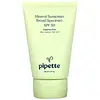What's inside
What's inside
 Key Ingredients
Key Ingredients

 Benefits
Benefits

 Concerns
Concerns

 Ingredients Side-by-side
Ingredients Side-by-side

Zinc Oxide 20%
Cosmetic ColorantWater
Skin ConditioningCaprylic/Capric Triglyceride
MaskingSqualane
EmollientGlycerin
HumectantCetearyl Alcohol
EmollientMethyl Dihydroabietate
Sorbitan Olivate
EmulsifyingCetyl Palmitate
EmollientCoco-Glucoside
CleansingEthyl Ferulate
AntioxidantCaprylyl/Capryl Glucoside
CleansingLecithin
EmollientBisabolol
MaskingPhysalis Angulata Extract
Skin ProtectingXanthan Gum
EmulsifyingAcacia Senegal Gum
MaskingSodium Gluconate
Skin ConditioningIsostearic Acid
CleansingPolyhydroxystearic Acid
Emulsifying1,2-Hexanediol
Skin ConditioningPolyglyceryl-3 Polyricinoleate
EmulsifyingHydroxyacetophenone
AntioxidantCaprylyl Glycol
EmollientZinc Oxide 20%, Water, Caprylic/Capric Triglyceride, Squalane, Glycerin, Cetearyl Alcohol, Methyl Dihydroabietate, Sorbitan Olivate, Cetyl Palmitate, Coco-Glucoside, Ethyl Ferulate, Caprylyl/Capryl Glucoside, Lecithin, Bisabolol, Physalis Angulata Extract, Xanthan Gum, Acacia Senegal Gum, Sodium Gluconate, Isostearic Acid, Polyhydroxystearic Acid, 1,2-Hexanediol, Polyglyceryl-3 Polyricinoleate, Hydroxyacetophenone, Caprylyl Glycol
Zinc Oxide 19.7%
Cosmetic ColorantBeeswax
Emulsion StabilisingBisabolol
MaskingButyrospermum Parkii Butter
Skin ConditioningCalendula Officinalis Flower Extract
MaskingCalophyllum Inophyllum Seed Oil
AntimicrobialChamomilla Recutita Flower Extract
MaskingEuphorbia Cerifera Wax
Helianthus Annuus Seed Oil
EmollientJojoba Esters
EmollientNasturtium Officinale Flower/Leaf Extract
AntiseborrhoeicOctyldodecyl Oleate
EmollientOryzanol
Skin ConditioningOryza Sativa Bran Oil
EmollientPersea Gratissima Oil
Skin ConditioningPueraria Lobata Root Extract
HumectantSimmondsia Chinensis Seed Oil
EmollientSpiraea Ulmaria Flower Extract
Skin ConditioningTheobroma Cacao Seed Butter
EmollientTocopherol
AntioxidantZinc Oxide 19.7%, Beeswax, Bisabolol, Butyrospermum Parkii Butter, Calendula Officinalis Flower Extract, Calophyllum Inophyllum Seed Oil, Chamomilla Recutita Flower Extract, Euphorbia Cerifera Wax, Helianthus Annuus Seed Oil, Jojoba Esters, Nasturtium Officinale Flower/Leaf Extract, Octyldodecyl Oleate, Oryzanol, Oryza Sativa Bran Oil, Persea Gratissima Oil, Pueraria Lobata Root Extract, Simmondsia Chinensis Seed Oil, Spiraea Ulmaria Flower Extract, Theobroma Cacao Seed Butter, Tocopherol
 Reviews
Reviews

Ingredients Explained
These ingredients are found in both products.
Ingredients higher up in an ingredient list are typically present in a larger amount.
Bisabolol is famous for its skin soothing properties. It does this by blocking inflammatory signals, helping to reduce your body's reaction to irritation.
This ingredient also interferes with the process of hyperpigmentation. This can help with reducing dark spots and uneven tone.
Bisabolol is an antioxidant. Antioxidants help fight free-radicals. Free-radicals are molecules that may damage your skin cells. By fighting these free-radicals, Bisabolol may slow down signs of aging.
Studies have shown Bisabolol to have antimicrobial properties and may be a fungicide. These properties help preserve a product's shelf life.
All these properties makes bisabolol a great skin barrier helper ingredient.
Bisabolol also helps the absorption of other ingredients.
Note: Synthetic Bisabolol has been shown to be less effective.
Learn more about BisabololZinc Oxide is a mineral broad-spectrum UV filter; it is the broadest UVA and UVB reflector approved by the FDA. It also has skin protectant and skin soothing properties.
Zinc oxide is one of the most effective broad-spectrum UV filters. It protects against UVB, UVAII, and UVAI. In comparison to its counterpart titanium dioxide, zinc oxide provides uniform and extended UVA protection.
Another great benefit? This ingredient is highly photostable so it won't degrade easily under sunlight.
A common myth is that mineral UV filters are widely believed to primarily reflect UV light.
However, modern research shows titanium dioxide absorbs UV radiation like chemical filters (~95% absorption & 5% reflection).
Zinc oxide has great skin soothing properties so you'll likely find this in sunscreens formulated for sensitive skin or babies/children. It is unlikely to cause "eye sting" like other sunscreen ingredients.
Regulatory agencies consider zinc oxide to be non-toxic and safe. It has also been shown to not penetrate the skin.
Unfortunately, this ingredient does leave a visible white cast. This is why mineral sunscreens are often less cosmetically elegant than chemical or hybrid ones.
In cosmetics, zinc oxide can be found in both non-nano and nano-sized forms. The nano version is used to reduce white cast and improve the texture of sunscreen formulas.
There are ongoing concerns surrounding nano-zinc oxide's impact on marine ecosystems and whether it can be absorbed into skin.
Regarding marine ecosystems and coral reefs, there is no conclusive evidence that any form of zinc oxide (or any other sunscreen ingredients) will cause harm. The science is still developing but many consumers are keeping a close eye on this issue.
Please note, many destinations have reef-safety sunscreen rules. For instance, the U.S. Virgin Islands advises all visitors to use non-nano mineral sunscreens.
There has also been some stir about whether micronized or nano zinc oxide has potential photoxicity and absorption through the skin/lungs.
An in-vitro (done in a test tube or petri dish) study demonstrated micronized zinc oxide to have potential phototoxicity. There's no need to fret; the EU Commission's Scientific Committee on Consumer Safety has stated, "The relevance of these findings needs to be clarified by appropriate investigations in vivo." Or in other words, further studies done on living organisms are needed to prove this.
Current research shows zinc oxide nanoparticles do not penetrate intact or sunburned skin. They either remain on the surface or in the outermost layer of dead skin (stratum corneum).
Zinc oxide is one of only two classified mineral UV filters with titanium dioxide being the other one.
Fun fact: Zinc has been used throughout history as an ingredient in paint and medicine. An Indian text from 500BC is believed to list zinc oxide as a salve for open wound. The Ancient Greek physician Dioscorides has also mentioned the use of zinc as an ointment in 1AD.
Learn more about Zinc Oxide